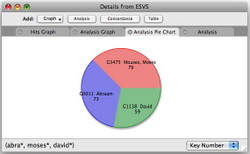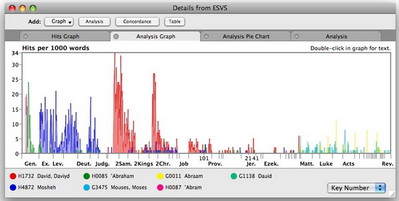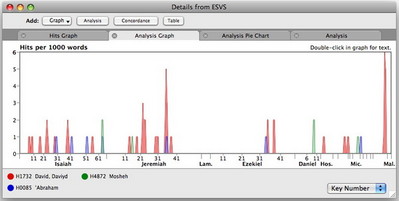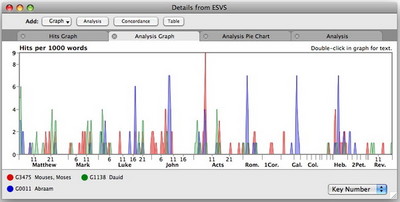Abraham. Moses. David.
Three figures from the Hebrew Bible face off in a clash of titans.
Abraham asks, “Who’s your daddy?”
Moses promises, “I’m gonna lay down the law!”
David shouts, “This is my house, and I rule!”
It’s a Bible figure smackdown!
Who will be left standing when the dust settles?
Okay, maybe I’ve seen one too many commercials for professional wrestling, but this Bible figure smackdown of mine is my answer to a serious question.
In a recent speed comparison of Mac Bible software programs, Rick Mansfield did a simple search for “David” which returned about 1,000 verses and compared how long it took each program to deliver the results. Accordance’s speed advantage was dramatic. Rick has since rerun his test under better conditions here, and while there is less disparity than before, Accordance still has a significant speed advantage—at least where this particular search is concerned.
Obviously, I was happy that Accordance came out looking good, but I was even more intrigued by the discussion which followed. Some people questioned the practical importance of Rick’s comparison by saying that it doesn’t matter how quickly a program delivers its entire search result, since “No one can read a thousand verses that fast anyway.”
My response to that objection is this: what if you do a search with no intention of reading all the hit verses? What if you merely want to gather the statistical information a particular search can provide?
The Bible Figure Smackdown is a simple example of what I mean. Abraham, Moses, and David are arguably the three most important figures in the Hebrew Bible. I want to compare where in both the Old and New Testaments these three figures are mentioned to get an idea of their relative importance in various periods and to various groups. So I’ll construct a simple OR search to look for any of these names across the entire Bible.
In Accordance, you can do an OR search by joining each word you want to find with the OR command. Another option is simply to list each word you want to find in parentheses. So with the English Standard Version with Strong’s numbers (ESVS) as my search text, I entered (abra*, moses*, david*) as my search argument. Unlike Rick Mansfield’s search for “David,” this search took a little longer to complete: a little less than one second.
Instead of a thousand verses, this search returns more than two thousand verses. But at this point, I’m not interested in reading them all. I just want to graph the results to get an overview of what was found. To do this, I click the Details button, and in the Details Workspace that opens, I’ll select Analysis Graph from the Graph pop-up menu.
The Analysis Graph plots the results of a search according to various criteria. Since I searched an English Bible with Strong’s numbers, it defaults to breaking down the search by all the Strong’s numbers that were found. I could also choose to have it broken down by the actual English words found. If I were searching a tagged Greek or Hebrew text, I could break the search down by specific grammatical criteria like Tense, Mood, Aspect, etc.
Graphing the results by Strong’s number is interesting because you can immediately see the distinctions between the Hebrew and Greek names for these three figures. You can also see immediately who got mentioned most frequently, not only by looking at the graph itself, but by looking at the order in which the Key numbers are listed (read from top to bottom, then left to right).
As you can see, in the Hebrew Bible, David is mentioned the most, followed by Moses, then Abraham. The graph shows the relative distribution of each Hebrew word. In the New Testament, Moses figures most prominently, then Abraham, then David.
All of this took a couple of seconds and a few mouse-clicks to produce, so I can immediately move from gathering information to analyzing it. If I want to look at any particular spike in the Graph, I can just double-click it. The Search window on which this graph is based will automatically scroll to the corresponding verses. If I want to focus on a particular portion of the Bible, I can go back to my Search window, set a range for the search, and search again.
Obviously, each man defends his own territory quite well. Abraham owns Genesis, Moses Exodus through Deuteronomy, and David the books of Samuel and Chronicles. David also dominates the Psalms. But what about those portions of the Bible which appeal to these three men as examples and types? On the “neutral sites,” which man wins the smackdown?
Let’s start with the Prophets (Isaiah-Malachi). By going back to the Search window, opening More Options, and selecting Prophets from the Range pop-up, we can zero in on this portion of the Bible. Running this search delivers the results instantaneously, and the Analysis Graph updates automatically. Just click the Details button to bring it to the front.
As you can see from this graph, David figures most prominently in the prophets, particularly in Isaiah and Jeremiah, and with the greatest frequency in Zechariah. Moses and Abraham are actually mentioned the same number of times in the prophets, a fact which can be seen more clearly by opening the Analysis window or the Analysis Pie Chart.
Why would David dominate the prophets? It probably has to do with the fact that the earlier prophets were concerned with the preservation of the “house of David” (that is, the nation of Judah), while the post-exilic prophets were concerned with its restoration. To confirm my hypothesis, I could turn to the actual search results and begin examining the hits in context. Or I could modify the search to exclude “house of David” and see how that affects the graph.
Now let’s look at the New Testament. Again, I simply need to change the range of the Search window and run the search again. The search is performed instantly and the Graph updates automatically.
 In the New Testament, David gets knocked off his throne by both Moses and Abraham. Moses retains a slight lead over Abraham, but they’re both mentioned roughly the same number of times. Interestingly, David gets mentioned most frequently in the Synoptics and the book of Acts, but very little in the epistles. Not surprisingly, Abraham shows a number of high spikes at places where the subject of faith figures prominently, such as Romans, Galatians, and Hebrews. Moses’ frequent mention raises a number of interesting questions. Are these references primarily focused on Moses as a synonym for the Mosaic Law? If so, are these references primarily positive or negative? Obviously, to answer these questions I would need to begin examining the hits in context or performing different searches.
In the New Testament, David gets knocked off his throne by both Moses and Abraham. Moses retains a slight lead over Abraham, but they’re both mentioned roughly the same number of times. Interestingly, David gets mentioned most frequently in the Synoptics and the book of Acts, but very little in the epistles. Not surprisingly, Abraham shows a number of high spikes at places where the subject of faith figures prominently, such as Romans, Galatians, and Hebrews. Moses’ frequent mention raises a number of interesting questions. Are these references primarily focused on Moses as a synonym for the Mosaic Law? If so, are these references primarily positive or negative? Obviously, to answer these questions I would need to begin examining the hits in context or performing different searches.
Anybody looking for a good subject to explore in their doctoral dissertation? 🙂
Whichever Old Testament figure you think wins the smackdown, I hope I’ve demonstrated that there are certainly times when you’ll want to perform broad searches and analyze the results in ways other than merely reading every verse. Accordance encourages you to ask these kinds of questions of the text by making it easy to get the answers.




